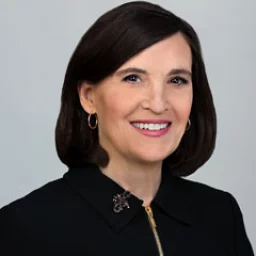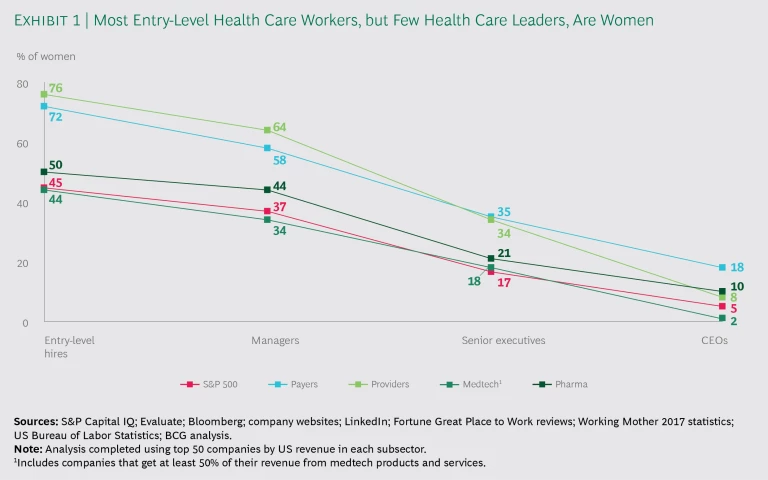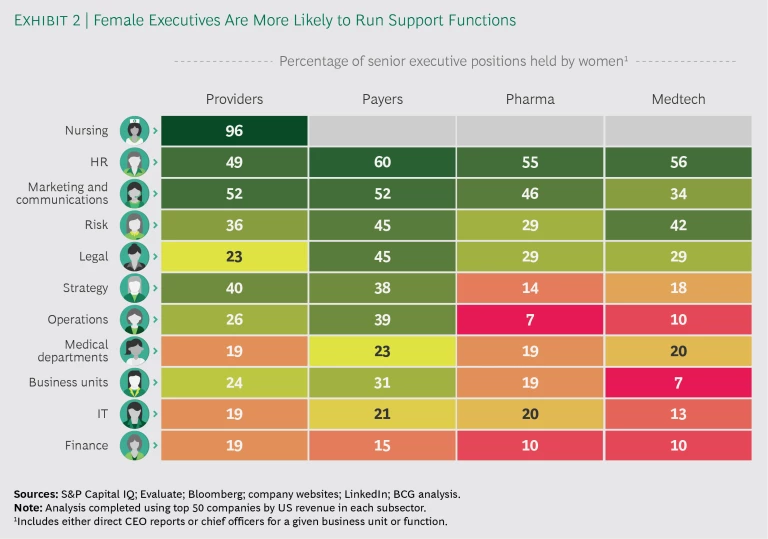The US health care industry is frequently cited as the gold standard for gender diversity. According to the US Bureau of Labor Statistics, 77% of the health care workforce is female, far higher than other industries. Yet in the executive suite, the share of women is only on par with other industries—that is, far lower than it should be—and it has not changed in the past decade.
Arguably, then, gender diversity is worse in health care—including payers, providers, pharmaceutical companies, and medtech firms—than in other industries. These companies have a wealth of talent to develop into senior positions, yet the industry still relies primarily on male leaders.
Health care companies have a wealth of talent to develop into senior positions, yet the industry still relies primarily on male leaders.
This isn’t an issue of fairness; gender diversity offers substantial benefits to organizations. According to BCG research, How Diverse Leadership Teams Boost Innovation : they are more innovative and generate higher financial returns. In the current health care environment, companies must innovate faster than ever to contend with disruptive forces such as new payment models, digital and e-health, and the increasing involvement of patients in decisions about their care. Given these pressures, companies need to tap all available insights, ideas, and perspectives.
We recently analyzed the share of women at all levels in the US health care industry. We also spoke with six exemplary female senior executives who have spent their careers in the industry. They served as thought partners, offering invaluable insights into both organizations and individuals. On the basis of that quantitative and qualitative work, we offer six initiatives that can help health care companies create truly balanced leadership teams.
A Bigger Funnel, but a Steep Drop-Off
Among payers and providers, women make up roughly 75% of entry-level employees, higher than in most other industries. At pharmaceutical and medtech firms, women make up roughly half of new hires at all levels, higher than for the S&P 500. Women also receive the majority of graduate and postgraduate degrees in health care subjects.
Yet at higher levels of seniority, the number of women in the industry drops off sharply. At the CEO level, the share of women essentially reverts to the average for the S&P 500. (See Exhibit 1.) Payers are an exception, where 18% of CEOs are women, but that’s a bright spot only in relative terms: it’s still just one-fourth of the entering population of women at these companies. And the picture is worse at the biggest health care organizations. Among the 50 largest payers, providers, and pharma companies (150 companies in all), only 18 have female CEOs.
The situation in medtech is particularly bleak; there is just one female CEO among the 50 largest companies in that subsector. One likely factor is the importance of a STEM background in medtech—and women represent only around 24% of the STEM workforce overall.
These numbers are abysmal. If anything, health care companies should be better positioned to create gender-balanced leadership teams. The industry has a much larger pool of women across the workforce than others, meaning that there is more talent to assess, develop, and promote into senior roles. It is especially challenging that men still outnumber women at the top of most US health care organizations, while women make up the bulk of the decision makers and end users of those organizations’ products and services.
There are two contributing factors. First, business unit heads are still predominantly men, while women tend to cluster in administrative functions such as HR, marketing, risk, and legal, as well as in nursing. (See Exhibit 2.) That could push women out of consideration for the most senior leadership roles. In addition, women have historically tended to bear the brunt of child care responsibilities. We know from previous BCG research that ambition levels among women do not change if they have children. However, if companies do not offer flexible work options and other supportive arrangements to new parents, some women may opt out of the workforce for a period. (This is also an issue for households in which both parents work.)
The data tells a clear story: recruiting isn’t the problem—it’s retention and advancement. A recent BCG survey supports this finding. Retention was the most cited obstacle to gender diversity, mentioned by 57% of respondents. Advancement was also a critical factor, cited by 50% of respondents.
Putting Women on an Equal Footing
Despite this challenging reality, we are optimistic that organizations that commit to diversity can turn the situation around. Our research and analysis point to six actions that health care organizations can take to increase the retention and advancement of women.
Highlight senior women as role models. As Nancy Schlichting, who spent more than a decade as the CEO of the Henry Ford Health System, says, “Women want to work in an environment with many other women to emulate as role models.” To help women at lower levels envision a path for themselves, senior women should be prominent, both internally and externally, and the organization should publicly celebrate them as examples of people who have risen to leadership positions.
NANCY SCHLICHTING
NANCY SCHLICHTING
Nancy Schlichting is the former CEO of the Henry Ford Health System.
Career Highlights
- Held senior executive positions at health care organizations for more than three decades
- Joined the Henry Ford Health System in 1998 as chief administrative officer
- Served as CEO for 13 years before retiring in 2016

For example, Laura Forese, MD, the COO and executive vice president of NewYork-Presbyterian—who has spent most of her career at the organization—hosts town halls with the CEO at all of the hospital’s campuses. That kind of frequent presence makes senior leadership visible and accessible.
LAURA FORESE
LAURA FORESE
Laura Forese, MD, is the executive vice president and chief operating officer of NewYork-Presbyterian.
Career Highlights
- Specialized in pediatric orthopedic surgery and became an associate professor at Columbia University
- Joined NewYork-Presbyterian in 2003 as vice president
- Held six roles, both corporate and operating, before ascending to the executive vice president and COO role for the entire enterprise

BCG research shows that if there are no senior female role models, women coming up through the ranks can’t see themselves reflected in the demographics at the top of the organization and, as a result, can’t relate to those in senior positions. Therefore, they may self-select out of promotion opportunities or, worse still, out of the company or industry completely.
Develop sponsorship programs for high-potential women. Many of the successful female senior leaders in health care we interviewed benefited from sponsors who helped guide them throughout their careers. These sponsors not only provided advice but also—more critically—served as advocates to make sure the women received fair consideration for promotions, high-profile projects, and other opportunities. Notably, sponsors can be men as well as women.
For example, Karen S. Lynch, the executive vice president of CVS Health and the president of the Aetna business unit, has received professional support from her “personal board of directors”—colleagues who have played a crucial role in guiding her decisions throughout her career. The key, says Lynch, is to maintain these relationships over time, even when you’re not in a direct working relationship with these people.
KAREN S. LYNCH
KAREN S. LYNCH
Karen S. Lynch is the executive vice president of CVS Health and the president of the Aetna business unit.
Career Highlights
- Began her career as a CPA at Ernst & Young
- Held various executive positions at Cigna and Magellan
- Joined Aetna in 2012 and ran various business units before becoming president in 2015

All too often, this kind of support happens only informally, by chance and circumstance, rather than through a carefully developed and maintained program. By creating formal sponsorship programs, companies can reach more high-potential women while they are still plotting their careers. (See “How High-Potential Women Can Help Themselves.”)
HOW HIGH-POTENTIAL WOMEN CAN HELP THEMSELVES
HOW HIGH-POTENTIAL WOMEN CAN HELP THEMSELVES
While there is much work ahead for organizations seeking to create gender-balanced leadership teams, the senior women we talked to said that midlevel women in health care can take steps of their own to improve their leadership prospects.
Take risks and be open to new opportunities. There are benefits to taking risks in your career. Laura Forese, MD, the executive vice president and COO of NewYork-Presbyterian, points out that women often don’t go for stretch opportunities. “Sometimes women see a job description that has ten things on it and say, ‘I don’t know, I haven’t done that, I have done this, but I’m not the best at it,’ which then becomes, ‘I can’t go for this job.’”
To avoid that kind of self-sabotage, women in health care should push themselves outside their comfort zones and seek out positions that require work across boundaries. For Karen S. Lynch, the executive vice president of CVS Health and the president of Aetna, this has included a rotation in HR, which she pursued at the suggestion of her sponsor. The experience gave her a front-row seat to understanding the time and commitment that leaders need in order to cultivate talented teams—a lesson that has stuck with her as a senior executive.
Speak up and let others hear your perspective. Nancy Schlichting, the former CEO of the Henry Ford Health System, guides women in health care to speak up. “Do you have ideas that are inspiring and drive change?” she asks. “Then jump into the deep end of the pool.”
Forese also points out the value of speaking out. “If you’re the only woman in a room,” she says, “be the bold voice in the room.” During her orthopedic surgery residency, she was often the only woman in the room among a group of 50 residents.
Because she stood out, she would get called on more frequently than her male colleagues. She turned this into a positive, using each question from the surgeons as an opportunity to demonstrate that she belonged in the room.
Focus on long-term success rather than short-term challenges. Several senior leaders highlighted the value of persevering through short-term challenges. “You will have setbacks,” says Lynch. “But whether you get up and how you get up are what really define your path.” Forese tells young women in health care that making mistakes in the short term is part of the job. “A 100% success rate all the time suggests to me that I’m not being bold enough.”
Mary Jo Williamson, the vice chair for administration and a trustee of the Mayo Clinic, emphasizes the importance of pushing through these mistakes. “Doing the work matters,” she says. “Results matter. Being a high performer may not always win in the moment, but it will in the long run.”
Standardize performance reviews and promotion criteria on the basis of hard metrics. The unconscious biases that affect performance reviews and promotions are a major contributing factor to gender imbalance. Even managers and leaders who believe they are completely objective are not. Forese provides an example: “The team was talking about a talented female executive and an open senior role, and someone said, ‘But didn’t she just have a baby?’ We would not have had this conversation if we were talking about a man who might also have just had a baby. Let’s instead ask, ‘Is this a role that she’d like to take on, because we think she’s qualified?’”
To address unconscious biases, companies must ensure that hiring and promoting managers make equal comparisons between men and women. They also need objective tools and metrics to make sure they’re getting it right (such as ensuring that equal percentages of men and women are being promoted and that shortlists for open positions include equal numbers of men and women).
Paula Steiner, the president and CEO of Health Care Service Corporation (HCSC), which operates five Blue Cross Blue Shield health plans, works closely with department heads and coaches to review the talent and performance profiles of the top 200 leaders at HCSC. The combination of direct involvement and rigorous measurement helps the company identify and track top talent. As a result, more women have been advancing to the officer ranks.
PAULA STEINER
PAULA STEINER
Paula Steiner is the president and CEO of Health Care Service Corporation (HCSC).
Career Highlights
- Began her career at the Blue Cross Blue Shield Association, rising to senior vice president of brand enhancement and extension
- Held several leadership roles with Blue Cross Blue Shield of Illinois and HCSC, including chief strategy officer at HCSC
- Became president of HCSC in 2015 and added the CEO role in 2016

At Aetna, leaders regularly review a customized nine-block assessment of each employee, along with feedback about the employee’s latest assignment, his or her time in role, and companywide metrics on rotations, promotions, and diversity. The key, says Lynch, is to make the talent strategy work hand in hand with the business strategy.
Hire and promote talent from unconventional sources. Increasing diversity requires bringing in people from unexpected sources, who have taken a variety of career paths. Earlier in her career, HCSC’s Steiner took a job turning around the sales team at Blue Cross Blue Shield of Illinois, despite a lack of sales experience. Winning the respect of her team required not only showcasing her analytical strengths and experience leading turnarounds but also learning from and relying on team members with experience in the field. “Tough challenges like that are great equalizers,” Steiner says. “The best people will be selected to solve the problem, regardless of gender, which promotes equality.”
A company culture that provides diverse experiences for employees can push people outside their comfort zones and prevent them from limiting their options. As Mary Jo Williamson, who has held several senior roles at the Mayo Clinic and currently serves as the vice chair for administration and a trustee, puts it, “Failure often results when someone gets fixated on one path.”
MARY JO WILLIAMSON
MARY JO WILLIAMSON
Mary Jo Williamson is the vice chair for administration and a trustee of the Mayo Clinic.
Career Highlights
- Started her career as a financial analyst at Andersen Consulting
- Held roles in operations, contracting, and payer relations at the Mayo Clinic
- Named vice chair for administration at the Mayo Clinic in 2014

Julie Creamer, a senior vice president at Northwestern Memorial HealthCare and the president of Northwestern Memorial Hospital, uses a similar approach in building project teams. “We like to include what we call a ‘naïve resource,’ someone who has no knowledge on the topic at hand.” Creamer says that those people often have fresh ideas and push teams to think about things differently, leading to better solutions.
JULIE CREAMER
JULIE CREAMER
Julie Creamer is a senior vice president at Northwestern Memorial HealthCare and the president of Northwestern Memorial Hospital.
Career Highlights
- Began with a nursing degree
- Worked in frontline staff, manager, and director positions for 16 years
- Joined the senior management team at Northwestern Memorial HealthCare in 1996

Companies also need to avoid relegating senior women to nonoperational roles. “Make sure you have diversity in the roles that matter,” Lynch says. “Have your critical talent, including women, run P&Ls. Put them in stretch assignments and support them if they struggle. That’s part of the commitment.”
Steiner also pointed out the complexity and interdependencies that exist with the health insurance market and the need to have a well-rounded background. A company culture that provides diverse experiences for employees is important. “You can’t just be an expert in one discipline” says Steiner. “The stakes are too high when you’re an officer to have your first experience outside your comfort zone. Leaders understand where they fit upstream and downstream, and they have comfort and familiarity across disciplines.”
Provide flexible work arrangements. BCG research has shown that companies make progress in gender diversity only if they have formal programs that help employees manage their work and nonwork lives, such as flex time, paid parental leave, and remote work through digital technology. These initiatives should be designed for both men and women , and tailored so that they are a regular, accepted part of a career, rather than disqualifying for the executive track. Steiner at HCSC notes that the company’s employees routinely rank flexible work as important, and it’s an area in which HCSC scores well. As NewYork-Presbyterian’s Forese says, “Careers are long, so having flexibility at various points in your life is critical.”
Measure what matters. Finally, to understand which strategies work most effectively in retaining and advancing women, it’s important to track results at a granular level and discuss them frequently. As Forese says, “The traditional performance-development model of ‘you’ll figure it out and once or twice a year we’ll have a conversation about how you’re doing’ is not good enough.” Instead, companies need to actively measure how they’re doing in gender diversity, both at the level of individual employees (who’s not advancing fast enough, who’s leaving the organization and why) and at the overall company level (how many women are in specific roles and at specific levels and which business units or functions are not showing enough progress in terms of diversity).
To understand which strategies work most effectively in retaining and advancing women, it’s important to track results at a granular level and discuss them frequently.
Steiner agrees. “Our board made a concerted effort to focus on diversity, and that has been a part of our culture for decades,” she says. “We’ve reinforced that through a focus not just on performance against goals, but also on how leaders achieve those goals. We share information on every leader’s diversity of new hires and of candidates interviewed and include diversity of staff and employee engagement as part of our bonus compensation.”
The health care industry has a lot of work to do in creating gender-balanced leadership teams, but in one sense it has a huge advantage: a workforce in which far more frontline employees and managers are women. To capitalize on that resource, it must take specific steps to improve the retention and advancement of high-potential women. Giving women an equal shot at the top is only fair. Moreover, greater gender diversity in the executive suite will make companies more innovative, giving them a clear advantage in a health care environment in which nonstop disruption is the norm.







